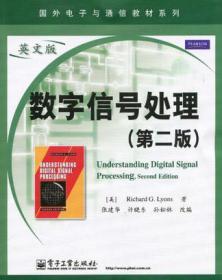
数字信号处理:第二版
¥ 17.79 4.7折 ¥ 38 九五品
仅1件
河北廊坊
认证卖家担保交易快速发货售后保障
作者Richard G.Lyons
出版社电子工业出版社
出版时间2010-07
装帧其他
货号A8
上书时间2024-11-22
- 在售商品 暂无
- 平均发货时间 12小时
- 好评率 暂无
- 最新上架
商品详情
- 品相描述:九五品
图书标准信息
- 作者 Richard G.Lyons
- 出版社 电子工业出版社
- 出版时间 2010-07
- ISBN 9787121111259
- 定价 38.00元
- 装帧 其他
- 开本 其他
- 纸张 其他
- 页数 289页
- 原版书名 understanding digital signal processing
- 【内容简介】
- 《数字信号处理(第2版)(英文版)》在Richard G. Lyons所著Understanding Digital Signal Processing , Second。Edition的基础上进行了改编,针对通信类学校本科教学大纲,删除了教学中一般不涉及的内容,调整了章节顺序,并增加了z反变换、滤波器结构、线性相位FIR滤波器及其结构、模拟滤波器简介的内容,使教材内容更加完整。全书在概述了离散序列和系统的定义和实例之后,详细讨论了离散系统的特性、信号的离散化和离散卷积、z变换、离散时间傅里叶变换和离散傅
- 【目录】
- *
1.1 Discrete Sequences and Their Notation 1
1.1.1 Discrete-time Signals 2
1.1.2 Frequently Used Discrete Sequences 7
1.2 Signal Amplitude, Magnitude, Power 9
1.3 Signal Processing Operational Symbols 10
1.4 Introduction to Discrete Linear Time-Invariant Systems 12
1.5 Discrete Linear Systems 12
1.5.1 Example of a Linear System 12
1.5.2 Example of a Nonlinear System 14
1.6 Time-Invariant Systems 16
1.6.1 Example of a Time-Invariant System 16
1.7 The Commutative Property of Linear Time-Invariant Systems 17
1.8 The Causality Property of Linear Time-Invariant Systems 18
1.9 The Stability Property of Linear Time-Invariant Systems 18
1.10 Analyzing Linear Time-Invariant Systems 19
1.11 Problems 20
1.12 MATLAB Applications 22
1.12.1 Applications 22
1.12.2 Examples 23
1.12.3 Exercises 24
Chapter 2 Periodic Sampling 25
2.1 Aliasing: Signal Ambiguity in the Frequency Domain 25
2.2 Sampling Low-Pass Signals 29
2.3 A Generic Description of Discrete Convolution 32
2.3.1 Discrete Convolution in the Time Domain 33
2.3.2 The Convolution Theorem 36
2.3.3 Applying the Convolution Theorem 39
2.4 Problems 42
2.5 Matlab Applications 43
2.5.1 Applications 43
2.5.2 Examples 44
2.5.3 Exercises 46
Chapter 3 Z-Transform 47
3.1 The z-Transform 47
3.1.1 Poles and Zeros on the z-Plane and Stability 49
3.1.2 The ROC of z-Transform 50
3.1.3 The Properties of z-Transform 53
3.2 The Inverse z-Transform 55
3.2.1 General Expression of Inverse z-Transform 55
3.2.2 Inverse z-Transform by Partial-Fraction Expansion 58
3.3 Problems 61
3.4 MATLAB Applications 63
3.4.1 Applications 63
3.4.2 Examples 64
3.4.3 Exercises 67
Chapter 4 The Discrete Fourier Transform 68
4.1 Interpreting the DFT 69
4.2 Understanding the DFT Equation 71
4.2.1 DFT Example 1 74
4.3 DFT Properties 81
4.3.1 DFT Symmetry 81
4.3.2 DFT Linearity 83
4.3.3 DFT Magnitudes 83
4.3.4 DFT Frequency Axis 84
4.3.5 DFT Shifting Theorem 85
4.4 Inverse DFT 87
4.5 DFT Leakage 88
4.6 Windows 94
4.7 DFT Resolution, Zero Padding, and Frequency-Domain Sampling 101
4.8 Frequency Response 104
4.9 Problems 106
4.10 Matlab Applications 107
4.10.1 Applications 107
4.10.2 Examples 108
4.10.3 Exercises 111
Chapter 5 The Fast Fourier Transform 112
5.1 Relationship of the FFT to the DFT 112
5.2 FFT Alogrithm 113
5.3 Derivation of the Radix-2 FFT Algorithm 114
5.4 FFT Input/Output Data Index Bit Reversal 120
5.5 Radix-2 FFT Butterfly Structures 121
5.6 Efficiently Performing the FFT of Real Sequences 127
5.6.1 Performing Two N-Point Real FFTs 127
5.6.2 Performing a 2N-Point Real FFT 133
5.7 Discrete Convolution using FFT 137
5.7.1 Overlap-added 138
5.7.2 Overlap-saved 138
5.8 IFFT Algorithm 140
5.9 Problems 143
5.10 Matlab Applications 144
5.10.1 Applications 144
5.10.2 Examples 144
5.10.3 Exercises 146
Chapter 6 Filter Structure 147
6.1 Block Structure 147
6.2 Mason and Transpose Theorem 149
6.2.1 Mason s Rule 149
6.2.2 Transpose Theorem 150
6.3 Example of Filter Structures 151
6.3.1 IIR Filter Structure 151
6.3.2 FIR Direct Structure 158
6.3.3 FIR Cascade Structure 158
6.4 Problems 159
6.5 Matlab Applications 162
6.5.1 Applications 162
6.5.2 Examples 163
6.5.3 Exercises 167
Chapter 7 Finite Impulse Response Filters 168
7.1 An Introduction to Finite Impulse Response (FIR) Filters 169
7.2 Properties of FIR Filters 172
7.2.1 Convolution in FIR Filters 172
7.2.2 Linear phase FIR Filter 181
7.2.3 Linear Phase FIR Filter Structure 188
7.2.4 FIR Filter Poles and Zeros 194
7.3 Low-Pass FIR Filter Design 196
7.3.1 Window Design Method 197
7.3.2 Windows Used in FIR Filter Design 204
7.3.3 Examples to Design Linear Phase Low-Pass FIR Filter 210
7.4 Examples to Design Other Types Linear Phase FIR Filter 215
7.5 Problems 220
7.6 Matlab Exercises 223
7.6.1 Applications 223
7.6.2 Examples 223
7.6.3 Exercises 224
Chapter 8 Infinite Impulse Response Filters 226
8.1 An Introduction to Infinite Impulse Response Filters 227
8.2 The Laplace Transform 229
8.2.1 Poles and Zeros on the s-Plane and Stability 234
8.3 Analog Low-Pass Filters 239
8.3.1 Introduction 240
8.3.2 Approximation of analog filter characteristics 240
8.3.3 Butterworth Approximation 242
8.3.4 Chebyshev Approximation 247
8.4 Impulse Invariance IIR Filter Design Method 253
8.4.1 Impulse Invariance Design Method 1 Example 258
8.4.2 Impulse Invariance Design Method 2 Example 260
8.5 Bilinear Transform IIR Filter Design Method 266
8.5.1 Bilinear Transform Design Example 271
8.6 Low-Pass IIR Filter Design 274
8.6.1 Example of Low-Pass IIR Digital Filter Design 274
8.6.2 a Brief Comparison of IIR and FIR Filters 277
8.7 Other Types IIR Filter Design 278
8.8 Problems 284
8.9 Matlab Exercises 286
8.9.1 Functions of IIR Design 286
8.9.2 Examples 287
8.9.3 Exercises 288












以下为对购买帮助不大的评价